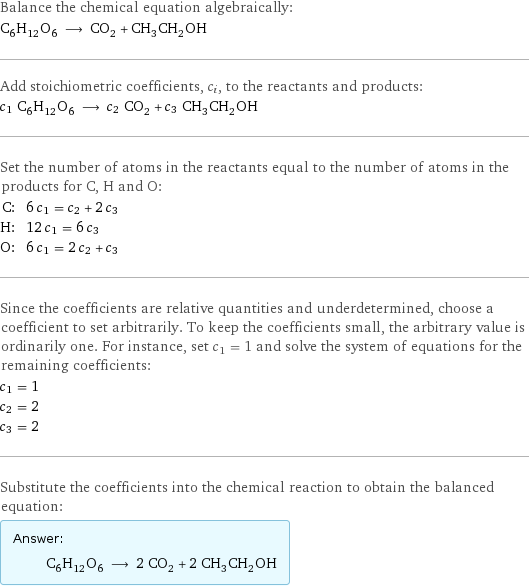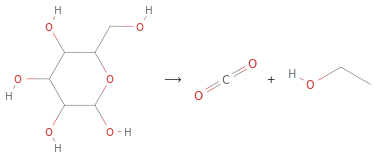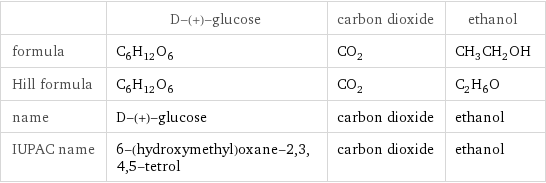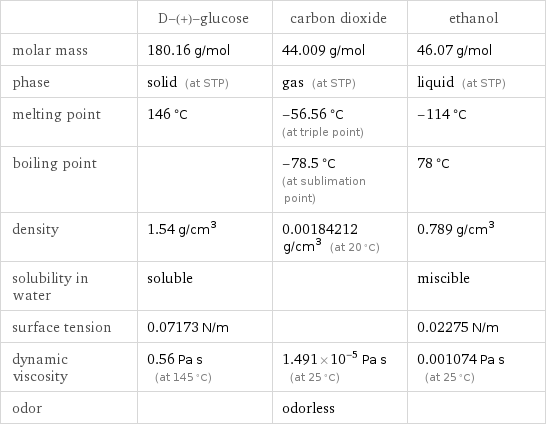Input interpretation

C_6H_12O_6 D-(+)-glucose ⟶ CO_2 carbon dioxide + CH_3CH_2OH ethanol
Balanced equation

Balance the chemical equation algebraically: C_6H_12O_6 ⟶ CO_2 + CH_3CH_2OH Add stoichiometric coefficients, c_i, to the reactants and products: c_1 C_6H_12O_6 ⟶ c_2 CO_2 + c_3 CH_3CH_2OH Set the number of atoms in the reactants equal to the number of atoms in the products for C, H and O: C: | 6 c_1 = c_2 + 2 c_3 H: | 12 c_1 = 6 c_3 O: | 6 c_1 = 2 c_2 + c_3 Since the coefficients are relative quantities and underdetermined, choose a coefficient to set arbitrarily. To keep the coefficients small, the arbitrary value is ordinarily one. For instance, set c_1 = 1 and solve the system of equations for the remaining coefficients: c_1 = 1 c_2 = 2 c_3 = 2 Substitute the coefficients into the chemical reaction to obtain the balanced equation: Answer: | | C_6H_12O_6 ⟶ 2 CO_2 + 2 CH_3CH_2OH
Structures

⟶ +
Names

D-(+)-glucose ⟶ carbon dioxide + ethanol
Equilibrium constant
![Construct the equilibrium constant, K, expression for: C_6H_12O_6 ⟶ CO_2 + CH_3CH_2OH Plan: • Balance the chemical equation. • Determine the stoichiometric numbers. • Assemble the activity expression for each chemical species. • Use the activity expressions to build the equilibrium constant expression. Write the balanced chemical equation: C_6H_12O_6 ⟶ 2 CO_2 + 2 CH_3CH_2OH Assign stoichiometric numbers, ν_i, using the stoichiometric coefficients, c_i, from the balanced chemical equation in the following manner: ν_i = -c_i for reactants and ν_i = c_i for products: chemical species | c_i | ν_i C_6H_12O_6 | 1 | -1 CO_2 | 2 | 2 CH_3CH_2OH | 2 | 2 Assemble the activity expressions accounting for the state of matter and ν_i: chemical species | c_i | ν_i | activity expression C_6H_12O_6 | 1 | -1 | ([C6H12O6])^(-1) CO_2 | 2 | 2 | ([CO2])^2 CH_3CH_2OH | 2 | 2 | ([CH3CH2OH])^2 The equilibrium constant symbol in the concentration basis is: K_c Mulitply the activity expressions to arrive at the K_c expression: Answer: | | K_c = ([C6H12O6])^(-1) ([CO2])^2 ([CH3CH2OH])^2 = (([CO2])^2 ([CH3CH2OH])^2)/([C6H12O6])](../image_source/8cdc0b37d03d1704b6677850e18fd159.png)
Construct the equilibrium constant, K, expression for: C_6H_12O_6 ⟶ CO_2 + CH_3CH_2OH Plan: • Balance the chemical equation. • Determine the stoichiometric numbers. • Assemble the activity expression for each chemical species. • Use the activity expressions to build the equilibrium constant expression. Write the balanced chemical equation: C_6H_12O_6 ⟶ 2 CO_2 + 2 CH_3CH_2OH Assign stoichiometric numbers, ν_i, using the stoichiometric coefficients, c_i, from the balanced chemical equation in the following manner: ν_i = -c_i for reactants and ν_i = c_i for products: chemical species | c_i | ν_i C_6H_12O_6 | 1 | -1 CO_2 | 2 | 2 CH_3CH_2OH | 2 | 2 Assemble the activity expressions accounting for the state of matter and ν_i: chemical species | c_i | ν_i | activity expression C_6H_12O_6 | 1 | -1 | ([C6H12O6])^(-1) CO_2 | 2 | 2 | ([CO2])^2 CH_3CH_2OH | 2 | 2 | ([CH3CH2OH])^2 The equilibrium constant symbol in the concentration basis is: K_c Mulitply the activity expressions to arrive at the K_c expression: Answer: | | K_c = ([C6H12O6])^(-1) ([CO2])^2 ([CH3CH2OH])^2 = (([CO2])^2 ([CH3CH2OH])^2)/([C6H12O6])
Rate of reaction
![Construct the rate of reaction expression for: C_6H_12O_6 ⟶ CO_2 + CH_3CH_2OH Plan: • Balance the chemical equation. • Determine the stoichiometric numbers. • Assemble the rate term for each chemical species. • Write the rate of reaction expression. Write the balanced chemical equation: C_6H_12O_6 ⟶ 2 CO_2 + 2 CH_3CH_2OH Assign stoichiometric numbers, ν_i, using the stoichiometric coefficients, c_i, from the balanced chemical equation in the following manner: ν_i = -c_i for reactants and ν_i = c_i for products: chemical species | c_i | ν_i C_6H_12O_6 | 1 | -1 CO_2 | 2 | 2 CH_3CH_2OH | 2 | 2 The rate term for each chemical species, B_i, is 1/ν_i(Δ[B_i])/(Δt) where [B_i] is the amount concentration and t is time: chemical species | c_i | ν_i | rate term C_6H_12O_6 | 1 | -1 | -(Δ[C6H12O6])/(Δt) CO_2 | 2 | 2 | 1/2 (Δ[CO2])/(Δt) CH_3CH_2OH | 2 | 2 | 1/2 (Δ[CH3CH2OH])/(Δt) (for infinitesimal rate of change, replace Δ with d) Set the rate terms equal to each other to arrive at the rate expression: Answer: | | rate = -(Δ[C6H12O6])/(Δt) = 1/2 (Δ[CO2])/(Δt) = 1/2 (Δ[CH3CH2OH])/(Δt) (assuming constant volume and no accumulation of intermediates or side products)](../image_source/7dec2d7e0d4160cb9a82823ab62b269f.png)
Construct the rate of reaction expression for: C_6H_12O_6 ⟶ CO_2 + CH_3CH_2OH Plan: • Balance the chemical equation. • Determine the stoichiometric numbers. • Assemble the rate term for each chemical species. • Write the rate of reaction expression. Write the balanced chemical equation: C_6H_12O_6 ⟶ 2 CO_2 + 2 CH_3CH_2OH Assign stoichiometric numbers, ν_i, using the stoichiometric coefficients, c_i, from the balanced chemical equation in the following manner: ν_i = -c_i for reactants and ν_i = c_i for products: chemical species | c_i | ν_i C_6H_12O_6 | 1 | -1 CO_2 | 2 | 2 CH_3CH_2OH | 2 | 2 The rate term for each chemical species, B_i, is 1/ν_i(Δ[B_i])/(Δt) where [B_i] is the amount concentration and t is time: chemical species | c_i | ν_i | rate term C_6H_12O_6 | 1 | -1 | -(Δ[C6H12O6])/(Δt) CO_2 | 2 | 2 | 1/2 (Δ[CO2])/(Δt) CH_3CH_2OH | 2 | 2 | 1/2 (Δ[CH3CH2OH])/(Δt) (for infinitesimal rate of change, replace Δ with d) Set the rate terms equal to each other to arrive at the rate expression: Answer: | | rate = -(Δ[C6H12O6])/(Δt) = 1/2 (Δ[CO2])/(Δt) = 1/2 (Δ[CH3CH2OH])/(Δt) (assuming constant volume and no accumulation of intermediates or side products)
Chemical names and formulas

| D-(+)-glucose | carbon dioxide | ethanol formula | C_6H_12O_6 | CO_2 | CH_3CH_2OH Hill formula | C_6H_12O_6 | CO_2 | C_2H_6O name | D-(+)-glucose | carbon dioxide | ethanol IUPAC name | 6-(hydroxymethyl)oxane-2, 3, 4, 5-tetrol | carbon dioxide | ethanol
Substance properties

| D-(+)-glucose | carbon dioxide | ethanol molar mass | 180.16 g/mol | 44.009 g/mol | 46.07 g/mol phase | solid (at STP) | gas (at STP) | liquid (at STP) melting point | 146 °C | -56.56 °C (at triple point) | -114 °C boiling point | | -78.5 °C (at sublimation point) | 78 °C density | 1.54 g/cm^3 | 0.00184212 g/cm^3 (at 20 °C) | 0.789 g/cm^3 solubility in water | soluble | | miscible surface tension | 0.07173 N/m | | 0.02275 N/m dynamic viscosity | 0.56 Pa s (at 145 °C) | 1.491×10^-5 Pa s (at 25 °C) | 0.001074 Pa s (at 25 °C) odor | | odorless |
Units
